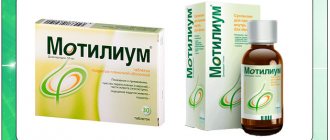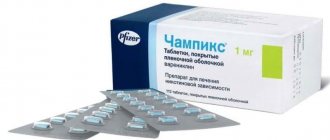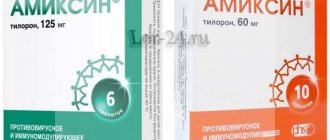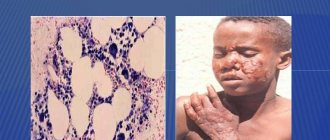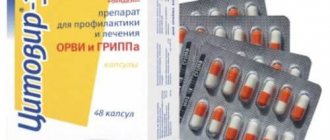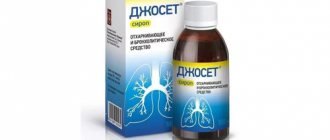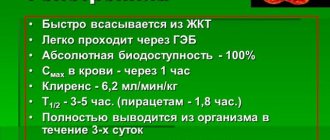Release form, composition and packaging
Suspension for intramuscular and subcutaneous administration in the form of a colorless or slightly opalescent liquid with a yellowish tint.
| 0.5 ml (1 dose) | |
| hemagglutinin and neuraminidase of the following viral strains*: | |
| A(H1 N1)** | 5 mcg GA*** |
| A(H3 N2)** | 5 mcg GA*** |
| B** | 5 mcg GA*** |
| azoximer bromide (polyoxidonium®) | 500 mcg |
Excipients: phosphate-saline buffer (potassium chloride, potassium dihydrogen phosphate, sodium hydrogen phosphate dihydrate, sodium chloride, water for injection) up to 0.5 ml; does not contain preservative.
0.5 ml - disposable syringes (1) - blister packs (1) - cardboard packs. 0.5 ml - ampoules (5) - blister packs (1) - cardboard packs. 0.5 ml - bottles (5) - blister packs (1 ) - cardboard packs.
* - produced by ABBOTT BIOLOGICALS BV, the Netherlands ** - the name of the strain is placed after the name of the type; the strain composition is brought into compliance with WHO recommendations for the current epidemic influenza season.*** - hemagglutinin.
What we know about flu vaccines
The essence of vaccination, and it is called specific prevention of influenza, is in infecting the vaccinated person after introducing weakened elements of the virus into the body.
The procedure causes a response, antibodies are produced to fight the pathogen, the process may be accompanied by muscle pain, increased fatigue with signs of lethargy. Vaccination can prevent the development of the disease or minimize its symptoms. Types of influenza vaccines used in anticipation of the epidemic period:
- Live vaccines. They contain weakened viruses, but cause flu-like symptoms, which allows the body to form sufficient immunity. However, vaccination with this type of drug is fraught with the development of dangerous reactions and complications. Injections also have a number of contraindications, which imposes restrictions on their use.
- Inactivated vaccines (whole virion). The viruses in these drugs are inactive; they are grown using chicken embryos and then inactivated using UV radiation and formaldehyde; they are not capable of causing influenza, but they can protect.
- Split vaccines. Split vaccines do not contain the viruses themselves, but fragments of their protein structures obtained by destroying viruses using a chemical substance. The additionally purified vaccine becomes less toxic, but maximally immunogenic. Method of administration: injection.
- Subunit vaccines belong to the latest generation of anti-influenza drugs; they are considered the most purified and also the least reactogenic with two viral antigens in their composition. The drug is characterized by a low number of side effects and is the safest.
Seasonal influenza vaccines approved for pediatric use
| Type of vaccines | Characteristics | Name | Route of administration and age |
| Alive | Live vaccine in dry form | Allantoic vaccine for intranasal administration | Intranasal, for children over 3 years of age |
| Inactivated | Whole virion drugs | Grippovac – inactivated influenza vaccine in liquid form | Intranasal, for children over 7 years of age |
| Split-split vaccines | Begrivak, Vaxigrip, Fluarix, Fluvaxin | Subcutaneously or intramuscularly, after 6 months | |
| Subunit, made on chicken embryos | Agrippal, Grippol, Inflexal, Influvac | Subcutaneously or intramuscularly, after 6 months | |
| Grippol Plus | Subcutaneously or intramuscularly, after 3 years | ||
| Subunit, produced in cell culture | Grippol Neo | Subcutaneously or intramuscularly, after 3 years |
pharmachologic effect
Influenza vaccine. Causes the formation of a high level of specific immunity against influenza. The protective effect after vaccination, as a rule, occurs after 8-12 days and lasts up to 12 months, incl. and in elderly people. Protective titers of antibodies to influenza viruses after vaccination of people of different ages are determined in 75-95% of vaccinated people.
The inclusion in the vaccine preparation of the immunomodulator polyoxidonium (azoximer bromide), which has a wide spectrum of immunopharmacological effects, increases the immunogenicity and stability of antigens, increases immunological memory, significantly reduces the vaccination dose of antigens, and increases the body's resistance to other infections by correcting the immune status.
Is a vaccine necessary? Doctors' opinion
There are tens of thousands of people who do not recognize vaccination, talking about its uselessness and the enormous burden on the immune system. Doctors are of the opposite opinion. Thanks to vaccinations, humanity has managed to cope with deadly diseases.
The “Grippol Plus” vaccine, which has only positive reviews from doctors, has proven itself to be the best. The vaccine does not cause serious complications. The fact is that the microorganisms are inactivated. This means that they are not alive, but killed by chemical action. Thus, the load on the body is minimal. The human immune system is able to cope with the introduced virus without consequences. At the same time, in an epidemic, the risks of getting sick after vaccination are minimal. This is evidenced by studies and population surveys.
The Grippol Plus vaccine, which has positive reviews, is a third-generation drug. Their benefits and effectiveness have been proven repeatedly. The vaccination can protect against strains of the virus type A and B. Doctors do not give a 100% guarantee that after vaccination a person will not become infected, but the deadly complications that the flu causes will definitely not arise.
The duration of action of the drug has also been increased. Thus, a vaccination given in the fall will protect not only this season, but also the next one. Many people believe that it is not worth injecting drugs against the influenza virus every year so that the human immune system can cope with the disease on its own. Doctors assure that this decision is wrong. If, after having chickenpox, the body develops lifelong immunity to this disease, this is not the case with the flu. Every year the disease will become more difficult to bear. Especially now that viruses have learned to mutate.
GRIPPOL PLUS: DOSAGE
Vaccination is carried out annually in the autumn-winter period. Vaccination is possible at the beginning of an epidemic rise in the incidence of influenza. The vaccine is administered in a dose of 0.5 ml intramuscularly or deeply subcutaneously into the upper third of the outer surface of the shoulder (into the deltoid muscle), and into the anterior outer surface of the thigh for young children.
Do not administer i.v.
Before use, the vaccine should be kept at room temperature and shaken well.
Adults (without age restrictions) and children aged 3 years and older are prescribed 0.5 ml once.
For patients with immunodeficiency and receiving immunosuppressive therapy, the vaccine can be administered twice, 0.5 ml, with an interval of 4 weeks.
Method of application and action
Vaccination is carried out between September and October. Vaccinations are allowed from childhood. In this case, the child must be at least six months old at the time of vaccination.
For each patient, injections are carried out in accordance with a specific scheme, namely:
Children in infancy and younger children under 3 years of age are vaccinated in two stages. The second injection is given 3-4 weeks later. In this case, the required dosage (0.25 ml) is administered intramuscularly into the front of the thigh.
- If the child is over 3 years old, he is given the vaccine in the form of one intramuscular or subcutaneous injection (dosage 0.5 ml). Injection into the upper outer part of the shoulder muscle is also allowed. Adults are vaccinated in the same way.
- In the presence of immunodeficiency, a two-stage vaccination is carried out (repeat after 3-4 weeks).
If children who have been vaccinated with Grippol Plus have not been vaccinated before, then the solution must be administered again after 30 days. Before injection, the drug must warm to room temperature. Next, a certain sequence must be followed:
The ampoule and bottle are opened in compliance with sterility rules.
- If the vaccine is administered to a small child, then half of the solution is poured out. There should be 0.25 ml left.
- The injection area is sterilized using a cotton swab soaked in alcohol.
Once opened, the drug must not be stored. It must be disposed of. After administration of Grippol Plus, it is better not to leave the medical facility for some time. It is important to monitor your own condition for 30 minutes in order to eliminate the post-vaccination complication in time.
You need to seek help from specialists when you experience:
- pale skin;
- noticeable restlessness;
- shortness of breath, breathing problems;
- swelling of the lips, tongue, ears;
- sudden rise in temperature;
- hives.
Upon arrival home, you need to prevent water from getting into the injection site. Swimming is allowed the next day. In this case, it is forbidden to rub the injection area.
Within a few days, it is worth changing your diet by introducing light foods with a minimum amount of calories. It is also worth excluding common food allergens.
It is also necessary to stop drinking alcoholic beverages. This is due to the fact that both the vaccine and alcohol reduce the body's immune defense.
When they are combined, suppression of the immune system and the appearance of allergic reactions can occur. Also, alcohol is prohibited due to polyoxidonium, which is a component of the vaccine. It is incompatible with alcohol.
Can pregnant women get vaccinated?
Grippol Plus is a purified vaccine. The conducted studies prove that the components do not have a negative effect on the growth and development of the fetus or embryo.
Since 2014, it has been allowed to vaccinate women expecting a child. It is important to discuss the upcoming vaccination with your doctor. He assesses the risks of contracting influenza and takes into account the possible reaction of the pregnant woman’s body.
The best period for administering the drug is considered to be the 2nd and 3rd trimester of pregnancy. You can also protect the body from the viral influence of influenza during lactation.
Adverse reactions and combination with other drugs
Grippol Plus is in most cases well tolerated by both adults and children. Therefore, after administration of the vaccine, no general or local reactions are observed.
Manufacturers of the drug note that, despite its harmlessness, negative side effects may occur. Among them are:
- local reaction in the form of hyperemia and swelling of tissues, accompanied by slight pain;
increase in body temperature to subfebrile levels;
- the appearance of headache, weakening of the body, rhinitis and hyperthermia (up to 38 ° C);
- slight aches in muscle tissue;
- allergic reactions (1 case per 10,000 patients).
The drug can be administered simultaneously with inactivated vaccines and live vaccinations. The exception is BCG and rabies injection. Vaccination can be carried out while the patient is taking medications necessary for the treatment of chronic diseases. In this case, the compositions do not affect each other.
Flu vaccination is becoming an increasingly popular and in-demand procedure. This is due to the frequency of influenza virus infections during the seasonal outbreak. To avoid complications, you need to carefully study the indications and contraindications, as well as possible side effects.
Drug interactions
Grippol® plus can be used simultaneously with other inactivated vaccines. In this case, contraindications to each of the vaccines used should be taken into account; drugs should be administered to different parts of the body with different syringes.
The vaccine can be administered against the background of basic therapy for the underlying disease. Vaccination in patients receiving immunosuppressive therapy may be less effective.
GRIPPOL PLUS: SIDE EFFECTS
Local reactions: rarely - pain, swelling, redness of the skin.
Systemic reactions: in some cases - general malaise, headache, fever, mild rhinitis, sore throat (these reactions usually disappear on their own after 1-3 days); extremely rarely (as with any other vaccination) - allergic reactions, myalgia, neuralgia, paresthesia, neurological disorders.
The vaccine is a highly purified drug and is well tolerated by adults and children. Local and general reactions to the vaccine are usually absent.
What are flu vaccines?
Flu vaccines
immunityvirus
hygiene WHO
Purpose of influenza vaccination
about 30% of the world's population
swine flu cough sneezing temperature infection
The most common complications of influenza are the following conditions:
- bacterial pneumonia ( pneumonia
); - lung abscess ( localized accumulation of pus in the lungs
); - acute and chronic sinusitis, tracheitis, pharyngitis;
- acute bacterial otitis;
- damage to the central nervous system ( meningitis, encephalitis
); - myocarditis ( damage to the heart wall
); - liver damage when using drugs containing acetylsalicylic acid ( Reye's syndrome
); - toxic-allergic shock.
vaccinations
Inactivated influenza vaccines. What are subunit vaccines?
antigens Inactivated vaccines according to the quality of purification are divided into the following types:
- Whole vaccines.
Contains purified, undegraded influenza virus particles. These vaccines are rarely used today, since further purification reduces the ability of the vaccine to cause allergies. - Split vaccines (
split ).
Contains surface and internal antigens of the influenza virus. They are purified from viral lipids and chicken protein. These include vaccines such as Vaxigrip, Begrivac, Fluarix. - Subunit vaccines.
Includes only surface antigens, hemagglutinin and neuraminidase. Because of this, they are considered the highest quality flu vaccines. Subunit vaccines include Influvac, Influenza and some other drugs.
Composition of influenza vaccines in 2020. Trivalent and quadrivalent vaccines
more than 2000 The composition of influenza vaccines in 2020 - 2019, recommended by WHO, includes the following strains of the influenza virus:
- A ( H1N1
) (
Michigan
); - A ( H3N2
) (
Singapore
); - B ( Colorado
); - B ( Phuket
).
bacteria
Storage conditions and periods
The drug should be stored out of the reach of children, protected from light at a temperature of 2° to 8°C; do not freeze. The drug that has been frozen cannot be used. Shelf life: 1 year. A drug that has expired cannot be used.
Transportation by all types of covered transport in light-proof containers at temperatures from 2° to 8°C, in conditions that exclude freezing. Transportation is allowed at temperatures up to 25°C for 6 hours.
Indications
Specific prevention of influenza in children from 3 years of age, adolescents and adults without age restrictions.
The vaccine is especially indicated for people at high risk of complications from influenza:
- over 60 years old,
- preschool children,
- schoolchildren;
- adults and children,
- those who often suffer from acute respiratory infections,
- suffering from chronic somatic diseases,
- incl.
- diseases and malformations of the central nervous system,
- cardiovascular system and bronchopulmonary system,
- bronchial asthma,
- chronic kidney diseases,
- diabetes mellitus,
- metabolic diseases,
- autoimmune diseases,
- allergic diseases (except allergy to chicken proteins),
- chronic anemia,
- congenital or acquired immunodeficiency,
- HIV-infected;
The vaccine is also indicated for persons whose profession has a high risk of contracting influenza or infecting others with it, including:
- health workers,
- employees of educational institutions,
- social service sector,
- transport,
- trade,
- police,
- military personnel.
Categories of people who are recommended to be vaccinated
There are cases when a flu shot is required:
- Children. Being constantly in a group, they have every chance of getting sick.
- Aged people. Weakened immunity and the presence of chronic diseases lead to the fact that a person has practically no chance of survival after suffering from the flu and its complications.
- People suffering from bronchial asthma.
- Teachers and educators who are in constant contact with children.
Doctors urge all citizens to be vaccinated in the autumn to prevent an epidemic.
special instructions
On the day of vaccination, a medical examination of the vaccinated person should be carried out with mandatory thermometry. At temperatures above 37°C, vaccination is not carried out.
The drug is not suitable for use in ampoules, vials, syringe doses with damaged integrity or labeling, if the physical properties (color, transparency) have changed, if the expiration date has expired, or if the requirements for storage conditions are violated.
In the rooms where vaccination is carried out, it is necessary to have anti-shock therapy. The vaccinated patient should be under the supervision of a health care professional for 30 minutes after immunization.
Rules for handling a disposable single-dose syringe (syringe-dose)
Before use, keep the vaccine at room temperature and shake the syringe immediately before injection. Remove the protective cap from the needle and remove air from the syringe by holding it in a vertical position with the needle up and slowly pressing the plunger.




